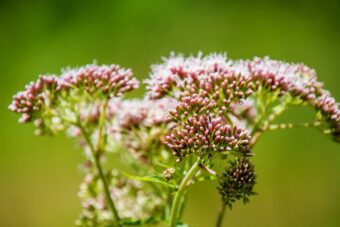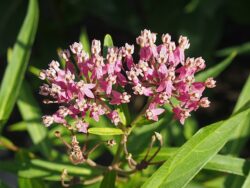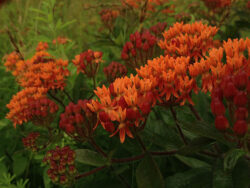In this article, we will discuss how to grow the unusual perennial Asclepias in containers. There are tender species but also hardy ones, which are recommended to be grown in the UK. It has the common name Milkweed because of the milky latex substance that can cause heart attacks, especially if the cells are damaged and the plant is consumed. Saying that there are insects, such as the Monarch butterfly who feed on the leaves and on the nectar the flowers produce. In fact, the larvae are host plants for these butterflies and use them for their survival.

It is a large genus with over 150 known species and belongs to the Apocynaceae family, the Dogbane family. The plants are most natively to North America and are noted for the small, intensively coloured blooms that are produced. Each bloom occurs in clusters and has a boss of upright ‘horns’ with reflexed petals below. The fruits that are formed often open to reveal silky hairs. Whilst not in flower the leaves are nothing to write home about as they are plain green, lance in shape and the flowers are produced on stout stems. The perennials are either evergreen or deciduous or subshrub.
The flowers not only look good but are often fragrant as well. Find out how to grow this perennial in containers in this article.
GROWING ASCLEPIAS IN CONTAINERS
You have a choice as you can grow Asclepias from seed or from garden-ready plants, where the latter is quicker and easier but more expensive.
SOWING ASCLEPIAS FROM SEEDS
You will need a period of cold stratification from the seed to germinate them. First, feel a plastic bag (with holes in them) full of moist silver sand and mix some seeds in them. Tie the bag at the end and place the bag in a fridge and wait for 4 weeks. After this time take the bag out and sow the seeds thinly on a tray of moist seed sowing compost. You will then need to add a thin layer of sieved compost and just cover the seeds. Cover with a propagation lid and place it in a warm area. Germination will be erratic but after 3 to 4 weeks, it will germinate.

After this, you can grow on in cooler conditions until the plant is big enough to handle. You will then need to prick them out and transplant them individually into 7.5cm pots full of multipurpose compost to grow on.
Once May has arrived and frosts have passed, you can acclimatise the plants by hardening off and planting out in late May. Ideally, you should sow the seeds in early February or March.
At this stage, you can treat your shop-bought plants and home-reared plants in exactly the same way. First, choose a large enough container that is well-proportioned with the plant and has plenty of drainage holes.
Into the container add a 1cm layer of gravel to aid drainage further and on top of this add a mixture of 80% by volume of multipurpose compost with 20% by volume of horticultural grit. This is important as it needs a well-draining growing media. Fill it to 5cm below the top rim of the container. Dig a hole in the centre slightly bigger than the root ball it came in the original container.
Drop the plant in so that the top of the root ball is at the same level as the top surface of the compost. Backfill with the growing media ensuring that no gaps remain, using more compost if necessary. Firm it in and water well.
GROWING CONDITIONS

Place the container in full sun as this is an absolute must but for most species that you find in the UK, the growing media must be moist. This means soon as the compost feels dry at the surface, it will need to be watered. When you water do so until it passes through the drainage holes.
You do not need to add any fertilizer unless the plant is obviously struggling, looking weak or not flowering well. In that case, you may give an annual dressing of fish, blood and bone or growmore.
You can divide congested plants in spring to create new plants. You will need to cut dead deciduous species in spring close to the ground, whilst for evergreen varieties, you will need to cut the spent blooms close to the leave joint after the flower spikes die.
PESTS AND DISEASES
Generally, milkweeds are pests and diseases free, but if you are unlucky, you will find that slugs and snails will nibble the leaves. You can protect the plants by using slug pellets or wool deterrent matting.
VARIETIES TO GROW
You will find two species on offer in the UK and both of them are hardy.
There is A. incarnata that grows up to 60cm high and produces heads of pink flowers from July to September. The flowers are followed by erect fruits. There is the pink ‘Cinderella’, the light pink ‘Soulmate’ and the white ‘Ice Ballet’.
The other is A. tuberosa which produces brighter flowers that are yellow, orange or orange-red. The flowers are produced over the same timeframe but it is a shorter plant (only growing up to 90cm high).
CONCLUSIONS
In this article, we have discussed how to grow the bright and beautiful Asclepias in containers. They are vital to the Monarch butterflies but they can be toxic to humans if you consume them or touch the irritating sap. The flowers are absolutely gorgeous and are well worth the effort for looking for.
They are easy to grow, easy to care for and are a delight in the container garden.
If you have any questions or comments that you wish to make on growing Asclepias in containers, please do so in the comment box below.
Happy Asclepias growing.
